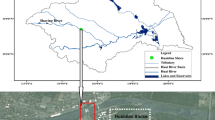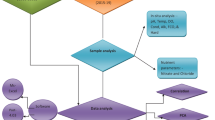Abstract
Recent research on the effects of dam and sluice construction on the water environment has attracted extensive attention from academia and governments alike. Because the operation of sluices greatly alters environmental factors such as water flow and sediment load, the water quality in sluice-controlled river reaches (SCRRs) undergoes complex changes compared with those in normal reaches. This work used river reaches near the Huaidian Sluice in Shaying River of China as a case study to analyse the effects of sluice operation on water quality evolution in SCRRs. The most influential factors affecting the rate of change in chemical oxygen demand (COD) concentration in SCRRs were identified through water quality monitoring experiments performed under various modes of sluice operation and by applying a statistical method ‘partial correlation analysis’. Then, a hydrodynamic model incorporating sluice operation and a water quality transport and transform model incorporating the release of endogenous loads were developed. Using these two models, the processes of temporal and spatial change of COD concentrations in the SCRRs were simulated under various scenarios designed to represent the dominant factors of influence. Finally, the simulation results were used to develop empirical relationships between the rate of change in COD concentrations and the dominant factors of influence. The results reveal that three factors, i.e., water inflow concentration, gate opening size, and gate opening number, are the dominant factors of influence, and there are logarithmic relationships between the rate of change in COD concentration in the SCRRs and these factors.








Similar content being viewed by others
References
Chen, H., Zuo, Q., Dou, M., & Ma, J. (2014). Comprehensive experimental research on impacts of dam operation on water environment of polluted river. Acta Scientiae Circumstantiae, 34(3), 763–770.
Dai, Y., Wang, D., Du, Y., et al. (2007). Water quality simulation for gate-controlled river net under influence of tides. Journal of Hohai University (Natural Sciences), 32(2), 135–139.
Dou, M., Zheng, B., Zuo, Q., & Jin, M. (2013). Identification of quantitative relation of ammonia-nitrogen concentration and main influence factors in the river reaches controlled by sluice. Journal of Hydraulic Engineering, 44(8), 934–941.
Hirsch, R. M., Alexander, R. B., & Smith, R. A. (1991). Selection of methods for the detection and estimation of trends in water quality. Water Resources Research, 27(5), 803–813.
Hu, W. (2012). The influence on the natural hydrologic regimes of the Huaihe River by Bengbu Sluice and its upstream dams. Scientia Geographica Sinica, 32(8), 1013–1019.
Huang, W., & Foo, S. (2002). Neural network modeling of salinity variation in Apalachicola River. Water Research, 36(1), 356–362.
Kurunc, A., Yurekli, K., & Okman, C. (2006). Effects of Kilickaya Dam on concentration and load values of water quality constituents in Kelkit Stream in Turkey. Journal of Hydrology, 317(1–2), 17–30.
Li, J., & Liao, W. (2002). The effect of water flow on the biodegradation of organic pollutant. Research of Environmental Sciences, 15(3), 45–48.
Li, D., Lin, Y., Liu, X., & Zhou, Z. (2010). Numerical model of one-dimensional unsteady flow for river networks with sluices and weirs and its application to combined-regulation of multi-sluices. Water Resources and Hydropower Engineering, 41(9), 47–51.
Liu, Z., Zuo, Q., Zhao, G., et al. (2011). Experiment of impacts of gate dispatching on water quality of polluted river. Journal of Water Resources & Water Engineering, 22(5), 34–37.
Marcé, R., Moreno-Ostos, E., García-Barcina, J. M., & Armengol, J. (2010). Tailoring dam structures to water quality predictions in new reservoir projects: Assisting decision-making using numerical modeling. Journal of Environmental Management, 91(6), 1255–1267.
McDonnell, R. A. (2000). Hierarchical modeling of the environmental impacts of river impoundment based on a GIS. Hydrology Process, 14(11–12), 2123–2142.
Mi, Q., Dou, M., & Guo, R. (2014). Research on the impact of sluice regulation on river’s water quality and water ecological process. Water Resources and Power, 32(5), 29–32.
Morris, G. L., & Fan, J. (1998). Reservoir sedimentation handbook: Design and management of dams, reservoirs, and watershed for sustainable Use. New York: McGraw-Hill. 704 pp.
Ruan, Y., Zhang, X., Xia, J., et al. (2009). Modeling impaction of date on contamination transfer in stream channel by ANN. Engineering Journal of Wuhan University, 42(9), 673–676.
Stanley, E. H., & Doyle, M. W. (2002). A geomorphic perspective on nutrient retention following dam removal. BioScience, 52(8), 693–701.
Stow, C. A., Borsuk, M. E., & Stanley, D. W. (2001). Long-term changes in watershed nutrient inputs and riverine exports in the Neuse River, North Carolina. Water Research, 35(6), 1489–1499.
Suo, L. (2005). Dams and ecology . China Water Resources, 42(16), 5–7.
Tiemann, J. S., Gillette, D. P., Wildhaber, J. L., & Edds, D. R. (2004). Effects of lowhead dams on riffle-dwelling fishes and macroinvertebrates in a Midwestern River. Transactions of the American Fisheries Society, 133(3), 705–717.
Tiffan, K. F., Garland, R. D., & Rondorf, D. W. (2002). Quantifying flow-dependent changes in subyearling fall Chinook salmon rearing habitat using two-dimensional spatially explicit modeling. North American Journal of Fisheries Management, 22(3), 713–726.
Xia, J., Zhao, C., Liu, M., Wang, G., Zhang, Y., & Liu, Y. (2008). Impact assessment of dams & flood gates projects of Huaihe River on river ecosystem: a case study of the Bengbu site. Journal of Natural Resources, 23(1), 48–60.
Xiao, J., Zeng, F., & Fang, H. (2009). Numerical simulation on the influence of sluice on water quality in tidal river network. Guangdong Water Resources and Hydropower, 38(12), 10–13.
Yu, S. J., Lee, J. Y., & Ha, S. R. (2010). Effect of a seasonal diffuse pollution migration on natural organic matter behavior in a stratified dam reservoir. Journal of Environmental Sciences, 22(6), 908–914.
Zhang, Y., Xia, J., Liang, T., & Shao, Q. (2010). Impact of water projects on river flow regimes and water quality in Huai River Basin. Water Resources Management, 24(5), 889–908.
Zhang, Y., Xia, J., Chen, J., & Zhang, M. (2011). Water quantity and quality optimization modeling of dams operation based on SWAT in Wenyu River Catchment, China. Environmental Monitoring and Assessment, 173(1–4), 409–430.
Zhang, Y., Xia, J., Shao, Q., & Zhang, X. (2012). Experimental and simulation studies on the impact of sluice regulation on water quantity and quality processes. ASCE: Journal of Hydrologic Engineering, 16(4), 467–477.
Zhang, Y., Xia, J., Shao, Q., & Zhai, X. (2013). Water quantity and quality simulation by improved SWAT in highly regulated Huai River Basin of China. Stochastic Environmental Research & Risk Assessment, 27(1), 11–27.
Zheng, B., Dou, M., Huang, L., et al. (2012). Analysis of sluice operation impact on diversification in water quality. Environmental Science & Technology, 35(2), 14–18.
Zubala, T. (2009). Influence of dam reservoir on the water quality in a small upland river. Ecohydrology & Hydrobiology, 9(2–4), 165–173.
Acknowledgments
The research was supported by the Natural Sciences Foundation of China (No. U1304509 and 51279183), the Program for Innovative Research Team (in Science and Technology) in University of Henan Province (No. 13IRTSTHN030), and the Scientific and Technological Project of Zhengzhou City, China (No. 083SGYG26122-6 and 0910SGYS33389-2).
Author information
Authors and Affiliations
Corresponding author
Rights and permissions
About this article
Cite this article
Dou, M., Li, G. & Li, C. Quantitative relations between chemical oxygen demand concentration and its influence factors in the sluice-controlled river reaches of Shaying River, China. Environ Monit Assess 187, 4139 (2015). https://doi.org/10.1007/s10661-014-4139-1
Received:
Accepted:
Published:
DOI: https://doi.org/10.1007/s10661-014-4139-1




